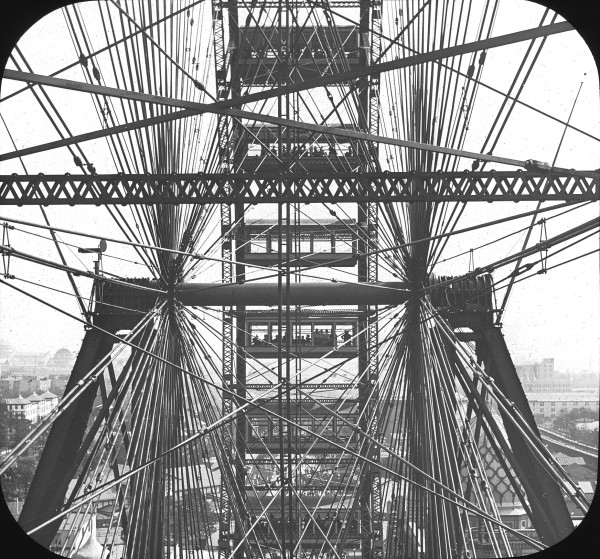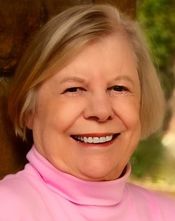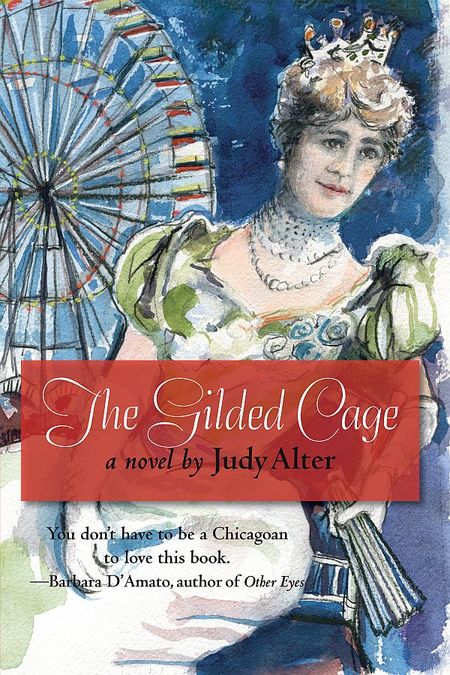Researching the Columbian Exposition for The Gilded Cage, I was fascinated by the history behind George Washington Ferris’ gigantic, people-carrying wheel. I took copious notes.
In 1889, the city of Paris erected the Eiffel Tower, an iron structure that stood 300 meters (well over 900 feet) tall and cast its magic over the city. In 1890 in Chicago architect Daniel Burnham, planning the Columbian Exposition, knew he needed a spectacular attraction, something that would outshine the Eiffel Tower. Engineers tried, suggesting crude toboggan schemes and all sorts of things. Eiffel offered to build a taller tower. None of it appealed until a young engineer sketched out a huge wheel with cars to hold people while they leisurely enjoyed a birds’ eye view of the city on their circular trip.
At first, Burnham rejected the wheel as too fragile, and Ferris spent his own money on safety studies. He hired engineers and recruited investors. Then he submitted the plans to Burnham again. His plan was chosen.
The first wheel had more than 100,000 parts, including the almost 90,000-lb. axle required to turn the wheel. Thirty-six passenger cars held 40 revolving seats plus a small serving area which offered champagne and light refreshments. The wheel took two revolutions in twenty minutes, making six stops for passengers to get on and off during the first revolution and no stops during the second so that passengers could marvel at the view. A ride cost fifty cents.
The wheel was placed, on strong and deep foundation pillars blasted out of then-frozen land in Jackson Park, in the Midway section of the fairgrounds. The Midway was adjacent to the luxurious grounds of the White City, as the principal buildings were called. These magnificent buildings were surrounded by lagoons featuring sculpture and fountains by such illustrious artists as Augustus Saint Gaudens. Buildings were hung with paintings by American artists Mary Cassatt and Edward Moran, Paderewski played a concert, historian Frederick Jackson Turner spoke as did novelist Theodore Dreiser.
On the Midway, the Ferris Wheel competed with less sophisticated but equally popular attractions such as Little Egypt, featuring belly dancers, and Wild Bill’s Wild West, deliberately kept just outside the grounds proper. But the wheel held its own, carrying 38,000 passengers daily at the height of the fair and over the wheel’s lifetime some two-and-a-half million.

World’s Columbian Exposition: Ferris Wheel, Chicago, United States, 1893.
The exposition closed in October 1893. George Washington Ferris immediately found himself entangled in lawsuits. Heavily in debt, he sued the city of Chicago for his fair share of the over $7 million the wheel brought in. The brief remaining period of his life was spent fighting for his wheel; he died, bankrupt, of typhoid fever in 1896.
The wheel was first dismantled and moved to an amusement park in Lincoln Park on Chicago’s North Side. In 1904 it was dismantled again and moved to St. Louis for the 1904 World’s Fair. Eventually a wrecking company bought and dismantled it. Ferris and his great dream both came to a sad end.
What was I to do with this history that fascinated me so? Nothing brings fiction to a cold stop like pages of factual material inserted into what we hope is the ongoing drama of the story. Yet many authors can’t bear to discard any of their research and cram it into their novels and stories.
The original Ferris wheel figures casually in several scenes in my novel of the exposition, THE GILDED CAGE. In one of my favorite scenes, Chicago Mayor Carter Harrison persuades (politely bullies?) Cissy Palmer, president of the Board of Lady Managers of the fair and wife of wealthy Chicago hotelier Potter Palmer, to ride the wheel with him, though Mrs. Palmer frowns on the Midway in general and Little Egypt in particular. Cissy Palmer, it turns out, is afraid of height, but Harrison calms her and by the time their cage reaches the apex of its first revolution, she is ecstatic that she can stand and see the Palmer mansion on the city’s North Shore. Harrison encourages her to remain seated.
This scene, created by my imagination, accomplishes several things: it speaks to the increasing illicit attraction between Cissy and the mayor, it emphasizes the enormity of the wheel and the massive work behind it, and it puts the reader, briefly, inside a cage in the largest Ferris wheel ever known and the only original Ferris wheel built by Ferris himself. Riders of today’s wheels, with two seat in a cage, should find it eye-opening. But I also hope it advances the dramatic arc of the book a bit.
About Judy Alter
An award-winning novelist, Judy Alter is the author of several fictional biographies of women of the American West. In The Gilded Cage she has turned her attention to the late nineteenth century in her home town, Chicago, to tell the story of the lives of Potter and Cissy Palmer, a high society couple with differing views on philanthropy and workers’ right. She is also the author of six books in the Kelly O’Connell Mysteries series. With the 2014 publication of The Perfect Coed, she introduced the Oak Grove Mysteries.
Her work has been recognized with awards from the Western Writers of America, the Texas Institute of Letters, and the National Cowboy Museum and Hall of Fame. She has been honored with the Owen Wister Award for Lifetime Achievement by WWA and inducted into the Texas Literary Hall of Fame and the WWA Hall of Fame.
WEBSITE | FACEBOOK | BLOG
THE GILDED CAGE by Judy Alter
Born to society and a life of privilege, Bertha Honoré married Potter Palmer, a wealthy entrepreneur who called her Cissy. Neither dreamed the direction the other’s life would take. He built the Palmer House Hotel, still famed today, and became one of the major robber barons of the city, giving generously to causes of which he approved. She put philanthropy into words, going into shanty neighborhoods, inviting factory girls to her home, working at Jane Addams’ settlement Hull House, supporting women’s causes.
It was a time of tremendous change and conflict in Chicago as the city struggled to put its swamp-water beginnings behind it and become a leading urban center. A time of the Great Fire of 1871, the Haymarket Riots, and the triumph of the Columbian Exposition.
Potter and Cissy handled these events in diverse ways. Fascinating characters people these pages along with Potter and Cissy—Carter Harrison, frequent mayor of the city; Harry Collins, determined to be a loser; Henry Honoré, torn between loyalties to the South and North; Daniel Burnham, architect of the new Chicago—and many others.
The Gilded Cage is a fictional exploration of the lives of these people and of the Gilded Age in Chicago history.
Historical [Author Self-Published, On Sale: April 18, 2016, Paperback / e-Book, ISBN: 9780996013123 / ]




No Comments
Comments are closed.